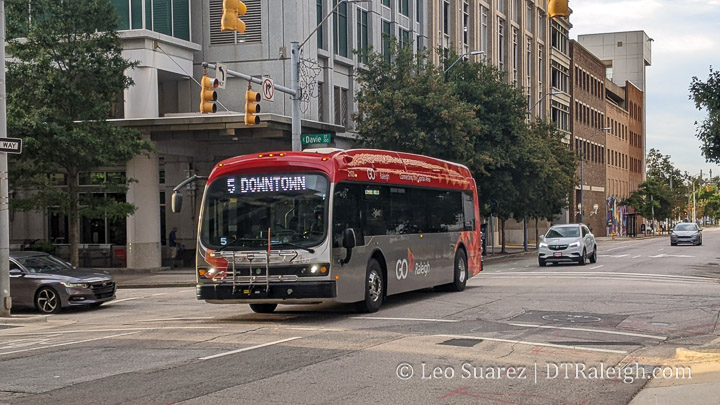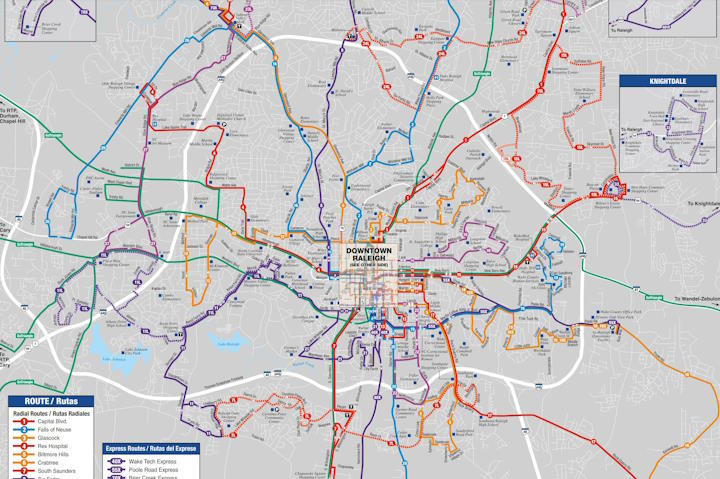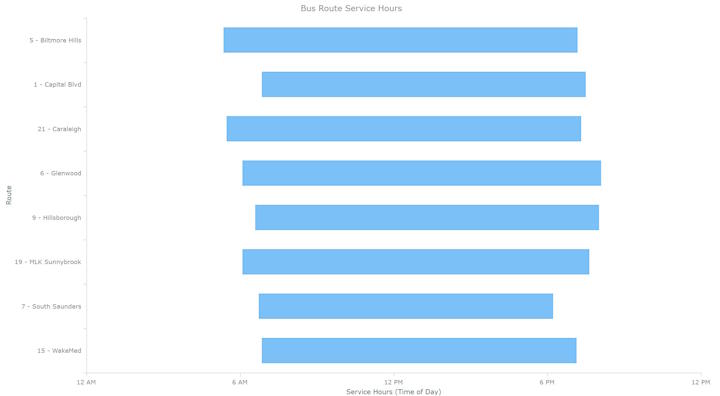
A new bus route, the #9 Hillsborough, started service in September of this year, offering 15-minute frequency between downtown and NC State seven days a week. This got me thinking about other bus routes that operate every 15 minutes—our definition of “high frequency” here in Raleigh.
I’m guessing you probably didn’t hear about this new route as you don’t use GoRaleigh. I feel confident with the claim as it’s estimated that only 2% of the Raleigh population uses the GoRaleigh bus system. (I may be off by a few percentage points but the point is, it’s pretty low) However, as Bus Rapid Transit grabs headlines these days, it’s the small details that are going unnoticed and there’s a case to reconsider GoRaleigh as part of your mobility toolkit.
On one end of the spectrum, some Raleighites exclusively drive cars. On the other, those without vehicles rely entirely on transit. In between, there’s a mix of walking, biking, transit, and driving in smaller amounts. This is where transit in Raleigh can make a compelling case—especially with bus routes arriving every 15 minutes, which could encourage more people to give it a try.
I wasn’t around to really experience GoRaleigh (then called Capital Area Transit) in the past, I’m talking about the 1990s for example, but from all the chatter and history I’ve heard, we’ve really made strides to improve service. Hourly frequency was common, with a sprinkle of 30-minute service during traditional AM and PM commuting hours. Buying a single replacement bus would consume most of the year’s transit budget. It’s no wonder we’re now so car-dependent.
An inflection point for transit in Raleigh, and Wake County to a degree, was the half-cent sales tax, which started collecting money in 2017. With a plan in place on how to spend it, those in transit planning have been building maintenance facilities to keep buses on the road for longer hours and breaking down less often. They have been upgrading bus stops with improved shelters, benches, and paved waiting areas. They have increased and improved the vehicle fleet with less diesel buses and more buses that run on compressed natural gas which lowers fuel costs and pollutes less.
In addition to longer service hours on some of our routes, we’re getting more frequent routes. Once I got a hand on the latest GoRaleigh transit data, I wanted to try and put that into a visual so we can actually see what that looks like. The case for using GoRaleigh for those that can drive any time gets stronger when you consider frequent service. But where can you go using this “frequent network”?
You can certainly search for it but I’m not sure anyone has highlighted the GoRaleigh Frequent Network on its own so that’s what I’d like to do today. You wouldn’t be wrong to think to look at the system wide map but it’s tough to see it there. (see the pdf here)

It’s pretty confusing, no? To be fair, GoRaleigh adjusts service on Saturdays and Sundays so visualizing all the routes in one image is a pretty complicated task. Thankfully, we have an online tool like GoRaleigh Live which does trip planning and shows a map with only the routes you are interested in and where the bus is located real time.
Here’s what the high frequency network looks like as of September 2024 on a weekday. Check it out larger here.
You can also dive into Saturday and Sunday service.
At one point, Raleigh had zero buses that showed up every 15 minutes. Today, we have the following:.
- Monday-Friday: 8 routes
- Saturday: 4 routes
- Sunday: 3 routes
Note: I’m not including the R-Line, which is also a high-frequency circulator service for Downtown Raleigh.
GoRaleigh’s core dynamic centers around a central hub—GoRaleigh Station—located in downtown. While this setup works well for those in or near downtown, it can be a limitation. Having to transfer at GoRaleigh Station often means longer overall trip times, which can make it a tough sell for those living outside the downtown area.
Eight high-frequency routes during the week is a great start, but let’s take a look at the service hours.

If you look at the overlap, you’ll notice that high-frequency service runs from 7 a.m. to just about 7 p.m. That’s a solid 12-hour span, covering both the traditional commuting hours in the morning and evening, as well as everything in between. For those with flexible work hours or midday errands, this window of frequent service could become convenient.
However, if GoRaleigh is going to be a serious alternative to driving, we’ll need to see this frequent network expanded, especially during off-peak hours and weekends. While 12 hours of high-frequency service is great, the fact that it tapers off in the evenings may deter potential riders who have later work shifts or evening plans. Extending the hours and adding more routes to the frequent network could further encourage people to leave their cars behind.
A greater challenge for GoRaleigh may be transitioning from a bus network that revolves around a downtown transfer to one with more crosstown routes. Not everyone wants to go downtown and while the buses are frequent, if it still takes over an hour to get to where you want to go, people won’t use it.
Ultimately, the expansion of GoRaleigh’s high-frequency network is a promising step forward for transit in our city. Once we get Bus Rapid Transit up and running, the frequencies may increase even more. That’ll continue to make the case stronger for letting someone else doing the driving.
In a future post, I hope to continue looking at the frequent network and see how many people live along these routes. That might show you that there’s a ridership population ready to go if only for a few more improvements.
Happy riding!
Comments
Comments are disabled here. That's because we're all hanging out on the DTRaleigh Community, an online forum for passionate fans of the Oak City.
